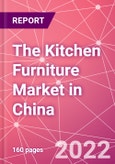Kitchen furniture exports and imports are broken down by country and by geographical region of origin/destination. Historical data are provided for the time frame 2016-2021. A similar analysis was conducted for the international trade of a list of selected appliances (refrigerator and freezers, cooking appliances, clothes washers and driers, dishwashing machines, hoods) relevant for the kitchen industry for the period 2016-2021.
Chinese kitchen production is analysed by including historical series of kitchen production in value and volume for the years 2016-2021. Kitchen production in China is broken down according to:
- style (classic, country, modern basic, modern, design, high tech);
- cabinet door material (solid wood, veneer, laminated, decorative paper, thermoplastics, lacquered, melamine, aluminium, glass);
- cabinet door colour (white, bright, neutral) and lacquering (bright, opaque);
- worktop material (solid surface materials, natural and engineered stone, laminated, tiles, steel and aluminium, wood, glass).
The chapter on the distribution system offers an analysis of the major sales channels (contract/building trade, kitchen specialists, furniture shops, furniture chains, and DIY) for kitchen and their 2014-2019 trends, including a list of the main kitchen furniture retailers in the major Chinese provinces and short profiles of the leading furniture chains. Reference prices for kitchen furniture and the weight of built-in appliances on the value of the kitchen market are also considered. The analysis also includes the profiles of 22 Chinese cities, which include economic and demographic statistics, kitchen demands, an indicator that ranks the cities according to their business attractiveness, and the analysis of the commercial areas of each city through the geolocation of over 65 brands.
An in-depth analysis of the competitive system identifies the leading Chinese manufacturers by kitchen production, sales, price range and exports. Updated company profiles of the top manufacturers provide data on the company's total turnover, number of employees, export share, location of manufacturing plants and distribution channels. The competitive system analysis also identifies a selection of leading international kitchen manufacturers operating on the Chinese market, providing descriptions of their distribution strategies and short company profiles.
The final chapter tries to identify the major domestic demand determinants, which includes macro-economic indicators (country indicators, real growth of GDP and inflation up to 2025, population indicators, data on disposable income and wealth, data on construction sector and real estate); population dynamics (population, urbanization, analysis of the top cities); consumers' trends and preferences; real estate and construction sector development (investments in residential building, data on the construction sector).
A list of more than 60 major players in the kitchen furniture industry in China is also included.
Table of Contents
Basic Data
Kitchen furniture supply structure
Annex II: List of Chinese companies mentioned and/or interviewed
Companies Mentioned (Partial List)
A selection of companies mentioned in this report includes, but is not limited to:
- Aisen
- Akani
- Amblem
- Aodu
- Arrow
- Baineng
- Beigeer
- Bigtime
- Borcci (Fotile)
- Borlonclan
- Cacar
- Canbo
- Daeshin
- Debao
- Deson
- Dicano
- Doton
- Elabor
- Eueasa
- Euromax Neuvelle
- Haier
- Hanex
- Haozhaotou
- Homtor
- Ikea
- Jiaci
- Joydar
- Kangjie
- Kenner
- Macess
- Macro
- Mekea
- Mkxy
- Nbmin
- Olo Home
- Oppein
- Oulin
- Oupu
- Ouyi
- Pianor
- Rebon
- Schmidt
- Siples
- Nobilia
- Vidas
- Vifa Kitchen
- Wanjia
- Welon
- Yalig
- Häcker Küchen
- ZBOM Cabinets








